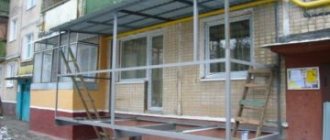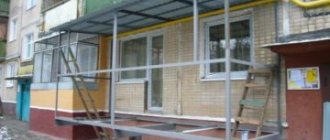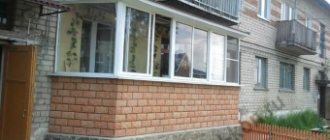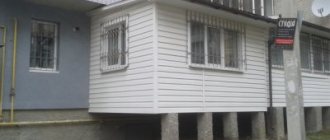Before buying real estate, you need to carefully weigh all the pros and cons so as not to get into trouble. Are you taking it higher? Why not! An apartment on the top floor has pros and cons
are mandatory, like any real estate. It’s just important to understand all the nuances and understand whether this is your option or whether it’s better to pass by. Read about this and more in the article.
From the window
A beautiful view from a window on a high floor can often be overshadowed by the fact that right in front of your windows they suddenly began to build another house, higher and larger. Here all your dreams of meeting sunrises and sunsets melted away like morning fog. But you don’t have to spend money on curtains to protect yourself from bright sunlight: this will no longer harm you. But if there are no houses in the area, then you can enjoy the view as much as you want.
— We live on the 24th floor. I doubted for a long time whether it was worth it, but my husband always had a dream - to make a panoramic window on the entire wall with a view of the city. Well, or to the forest and part of the city, as it turned out in the end. Before buying an apartment, we consulted with a doctor we knew. He said that altitude does not affect the body in any way, although there are many reviews on the Internet saying that a person should not get too far off the ground, as there may be health problems. Pah-pah-pah, I haven't noticed yet. Although some friends claim that they feel dizzy when they come to us and look out the window. At first it was unusual for me too, but now it’s a common thing. One of the advantages is a gorgeous view, no one is blocking anything from you. On the 25th it would have been even cooler, but they didn’t take the last floor of the house so that there would be no problems with the leaking roof. But when you live for a long time, you already get used to beauty, so it makes more impressions on friends and family, and not on us.
— I have advantages - a huge balcony and a view (13-story building, located on the mountain). When you look from the balcony, it takes your breath away. View of gorgeous nature. I love living at heights.
Benefits of "life at the top"
If we talk about the advantages of housing on the top floors, they differ little from standard apartments on the secondary and primary markets. The most obvious of them is the absence of constantly disturbing neighbors upstairs, which means getting rid of additional noise and no risk of becoming a victim of flooding of the apartment due to the negligence of the “upper residents” or problems with pipes and taps. However, the condition of your own plumbing, as well as dishwashers and washing machines, must be monitored very carefully, especially if the house is old.
In addition, buying an apartment on the top floor means not hearing the noise of the sewer system, which haunts particularly impressionable residents of the middle and lower floors. In addition, you can save on updating communications. Apartments on the top floors do not have running pipes for water supply, heating and sewerage. Therefore, if necessary, replacing these elements will be much easier and cheaper.
Apartments in many new buildings can be converted into penthouses if the necessary permits are obtained. However, professionals claim that this world-famous housing in Russian open spaces is just a status toy. The difficult climate and imperfect construction technologies mean that life “in seventh heaven” can be overshadowed by very prosaic basins that will have to be placed under fresh streams of rainwater.
In addition, residents of such prestigious apartments often find themselves wanting to cover the glass walls of the “view” transparent living room with very thick curtains.
The air on the upper floors is cleaner, especially if these are apartments in high-rise buildings where there are no production pipes nearby. Heavy connections and exhaust gases from the roadway reach a maximum of the fifth floor, although everything here is conditional, since the ceiling heights in the houses are different. As for emissions from enterprises, they are more dangerous for residents of upper floors, so it is better to live lower in industrial zones.
New buildings often have two elevators, and cases of failure of two elevators at once are quite rare. In many modern buildings, elevators have ceased to be a source of eternal noise and vibration, since the shafts are separated from the apartments by special halls. However, considerable difficulties can arise when lifting large things that do not even fit into a freight elevator, but you don’t have to deal with them so often. In fact, you can always find professional movers who can find a solution to the problem of moving such items into your apartment.
Apartments on the upper floors, especially in high-rise buildings, are well lit at any time of the year. Being protected from prying eyes, residents can never close the curtains. Well, or, at least, until the moment when an even taller new building appears opposite.
As realtors note, apartments on the top floors in new buildings sell better than those on the first floors. Buyers choose peace and tranquility, since all the street noise and bustle remain far below, and beautiful sunrises and sunsets become constant companions.
Elevator
It's good if it's always working. Or there are two of them at once, or better yet, three! But if the elevator breaks down or the electricity goes out, walking to the 16th floor is a real joy. Bonus - heavy bags at best, a stroller as an apogee.
And if you are lucky enough to live directly opposite the elevator, that’s great. No extra steps. Well, the constant rattling of doors will replace the music.
— I live on the 16th floor. If the elevators are broken, it's a complete nightmare. It took me about 20 minutes to mentally prepare for this ascent.
— All my life I lived on the 16th, and it seemed to me that I was living so low. I dreamed of taking the 35th approximately, but in the end life only brought me to the 25th. In my lifetime, elevators have broken down three times when electricity was cut off in the entire building; I remember this happened in the 90s. It is important to look at where the elevator shafts are located. If they are near the apartment, there will be an eerie monotonous hum that will drive you crazy with vibration.
“Everyone was scared by the fact that elevators often break down, but in practice they only broke down once during the entire time that we lived in a high-rise building. In addition, all modern buildings have spare elevators in case of an emergency.
Top cons
Residents of the upper floors always take an empty elevator. This is a definite plus, especially when you need to transport large items downstairs. But the definite disadvantage of living on the upper floors is that the elevators tend to break down, and then you have to go down yourself with strollers, suitcases, and bicycles.
“In many modern buildings with a height of more than 30 floors, modern super-high-speed elevators are often installed, which, on the one hand, have increased power and reduce travel time, and on the other hand, can affect pressure fluctuations in the blood vessels of susceptible people and cause some temporary discomfort,” warns Anisimova.
Residents of the upper floors also complain about weaker water pressure than their neighbors on the lower floors. It’s also hotter and more stuffy at the top than at the bottom.
Cheap, but there are some nuances. Is it profitable to buy apartments? More details
Hot (and cold) water
If you live on a high floor, you will most likely have to forget that the water pressure can be strong. And sometimes you can only dream about warm water. Especially if you decide to carry out water procedures at the same time as your neighbors. And in other houses there are problems with cold water.
— In the mornings, it is sometimes difficult to ensure that cold water flows from the tap, but I like to wash my face with cold water. It just flows cool. There are no problems with pressure, and especially with changes in water temperature.
Which floor is better to live on?
It is traditionally believed that the most inconvenient floors are the outer ones, that is, the first and last. We tried to find out how true this is for modern new buildings, and also analyze each tier in the house and find the pros and cons of living on a particular floor.
Expensive height Nowadays, the first floors of new houses are almost always allocated for “non-residential” use: there are commercial premises (shops, pharmacies, cafes, dry cleaners, offices, etc.), social facilities (kindergartens, clinics or specialized doctors’ offices) or built-in garages. Therefore, the first residential floor is rarely “extreme”. However, in some cases the first floors are left as residential. This is typical for residential areas with little pedestrian traffic, for areas with a favorable environment (for example, in the suburbs) or for residential complexes of the highest categories (“business” and “elite”), which are built in prestigious locations and have a closed courtyard area isolated from roadway and neighboring houses of lower classes. For example, in the elite quarter of Dudergof club in the “Baltic Pearl” the first floors of low-rise buildings are residential. Just like, say, in the residential complex “Equilibrium” from “Trust 36” on Vyborg highway. The upper floors, too, today are usually not the last (of residential ones) - technical rooms are arranged there. The traditional problem for high-rise residents in Soviet-built buildings is that the water pressure here is often much lower than on the first floors, since water is supplied from the bottom up. Now developers claim that modern technical solutions make it possible to forget about this problem. Although you can often read opposite reviews on the websites of equity holders. True, this mainly applies to “austerity” houses, where developers try to minimize costs as much as possible. However, it is difficult to overcome stereotypes. According to a Moscow survey (no such studies were conducted in St. Petersburg, but, obviously, the opinion of our fellow countrymen is not much different), about 55% of respondents prefer the upper floors to the lower ones. Moreover, 21% of Muscovites are categorically against the first and last floors. Only 11% “stretch to the ground”, not wanting to rise above the fifth. For 2% of respondents, it does not matter at what altitude to live, as long as the price of the apartment is affordable. Oleg Pashin, General Director of TsRP Petersburg Real Estate LLC, notes that this position is typical for buyers of economy-class housing. For them, neither the view characteristics of the apartment nor environmental friendliness are important. Therefore, usually in the “economy” and “comfort” segments, the cheapest apartments are located on the first floors. On average, their cost is approximately 10-15% lower than that of more “elevated” options.
Let's say, in the residential complex "Austrian Quarter" from the "Polis Group" 22-meter studios on the ground floor are sold for 1.7 million rubles, and on the 19th - for 2 million, that is, 17.64% more expensive. "YIT" in the residential complex "Novomoskovsky" has a "one-room apartment" with an area of 40 square meters. m on the first floor was put up for 5.68 million rubles, and on the tenth - for 6.37 million - 12% more expensive. In the “Pearl Symphony” apartments with an area of 45 sq. m on the second floor cost 3.7 million rubles, and on the 17th - 4.5 million, 21.62% more. The difference in price is directly proportional to the difference between floors and largely depends on the views from the windows. In some cases, this difference can reach 50-70%. For example, in the Cosmos residential complex, which is being built by Setl City, on the upper floors (there are three buildings in the complex - 18, 20 and 22 floors) there are the most spacious apartments overlooking Victory Park, and the price for them differs from those located on lower tier, by 70%. Such a significant difference is observed primarily in residential complexes of the highest categories, where, in contrast to “comfort” and “economy”, views from the windows are a fundamental factor for buyers. Therefore, in the same “business” complex, apartments that “look” at a park, pond or historical landmarks can be 20% more expensive than those of the same area, but with more modest views. And the upper and lower floors in premium houses differ in price by 30-50%, says Oleg Pashin. According to Natalya Komissarova, director of the residential real estate department at the Home estate real estate agency, young people usually like to live at the top. The older the buyers, the lower the floor they choose. Let's look at the advantages and disadvantages of different floors.
The first is bad because it is unsafe - thieves can easily get into it. Residents commonly install bars on their windows, obstructing views and darkening rooms. Here you can hear everything that happens on the street, all external odors reach here, insects penetrate here, and dampness is often felt. The stairwells are dirtier than those upstairs. However, the first floor has many fans, says Natalya Komissarova. “These are elderly people, as well as people with disabilities. They also look at whether the house has convenient exits and whether the area is well cleaned. The first floors attract young mothers who often have to walk with small children,” she explains. There are also people who have always lived on the first floors and are not ready to change their habits. Or those who are afraid of heights, do not trust the quality of elevators, etc. For some, it is important that in the event of a fire or other troubles, it is much easier to leave an apartment on the first floor than, say, on the 15th. Considering that in many new buildings the elevators often break down, and in some cases do not work at all for some time after moving in, when residents make repairs and buy furniture, the first floor looks quite attractive. And don’t discount those for whom apartments on higher floors are unaffordable.
The second has almost all of the disadvantages of the first. The only exception is that from the street it is almost impossible to see what is going on in the apartments on the second floor, and fewer visitors to the house pass by your apartment than those located on the floor below (especially if the building has an elevator). Otherwise, almost everything is the same - both minuses and pluses. There is, perhaps, one specific drawback: if the ground floor is given over to commercial use (trade, cafe, club), living on the second floor is even worse than on the first - noisy, unpleasant odors, and even cockroaches.
Third to fifth Climbing the stairs, even if the elevator breaks down, is not so difficult; bringing furniture, household appliances and finishing materials will also cost less than going to the very top. At the same time, there is no dampness or a large number of insects at this level; only the residents of the building opposite will be able to look into your windows, but this does not depend on the floor. If, God forbid, the apartment catches fire, then fire escapes reach here and you can jump onto the awning stretched out by firefighters. The fifth floor (approximately 15-20 m from the ground, depending on the height of the ceilings in the apartments) is not the height that people obsessed with the fear of heights fear. However, exhaust from vehicles and other street odors perfectly reach the fifth floor. Audibility here is also good, especially in courtyards formed by several buildings located in a circle.
Sixth-tenth Many residents consider this zone ideal. Exhaust gases are practically not felt here anymore, trees higher than the sixth floor are a rarity in cities, so light penetrates into apartments unhindered. The only sad thing is that the sounds from below are still disturbing, and even lifting heavy objects becomes more and more expensive with each floor.
Tenth-fifteenth Almost all the “lower” flaws have disappeared. Only particularly loud sounds, such as car alarm sirens, can disturb new residents. But starting from this height, the disadvantages characteristic of this particular level already appear. At least the same alarm: if it goes off on your car, you’ll have to run a short distance downstairs to turn it off. A non-working elevator is already becoming a serious problem. The apartment is bright and there is no exhaust from cars, but if there is a thermal power plant or boiler room nearby, you will feel the proximity to their pipes. The fear of heights on the tenth floor can already make itself felt. You probably won't be able to jump out of the window in case of fire, although the stairs still reach here. Cleaning windows yourself can be scary. If there are young children in the family, you need to vigilantly ensure that they do not end up near an open window or on the balcony unattended. A fall from such a height is fatal.
Sixteenth and above No smells, no noises, no street dust and dirt. It’s warm, light and flies don’t bite; you can admire beautiful views from the balcony. On the extreme floors it becomes possible to equip an exit to the roof. But the faint-hearted are afraid to approach the windows, not to mention the balcony; a breakdown of the elevator turns into a nightmare, and in the event of a fire there may be big problems with going outside. Especially for those who live above the 25th floor, fire escapes extend only 75 m. And it is difficult to extinguish fires in skyscrapers, as Muscovites have already been able to see for themselves by observing a series of fires in Moscow City high-rises. True, as they said in the RosStroyInvest Group of Companies, which erected the recently commissioned residential complex "Prince Alexander Nevsky" (the first St. Petersburg skyscraper), to ensure fire safety in the 35-story complex (height 100 m) it was necessary on every floor and in every room install a special fire extinguishing system, a smoke removal system and an alarm system with notification in case of fire. Washing windows at the level of some 28th floor is very dangerous even for those who are not usually afraid of heights - they may feel dizzy.
You have a product - we have a merchant. Each buyer has his own priorities when choosing an apartment. For one, running up to the 26th floor is not a problem, but he absolutely cannot stand car exhaust. Another is ready to inhale exhaust fumes and listen to the barking of dogs that neighbors walk in the yard at night, just so that they don’t have to see the city from a bird’s eye view every day. The third one would be glad to feel like a bird, but there is no money for an apartment in the upper tier of a skyscraper. There is a buyer for every product, fortunately, developers today offer a variety of options - from low-rise complexes to skyscrapers.
Text: Olga Myagchenko Photo: Alexey Alexandronok
The roof is leaking
If your high-rise building is not new, be sure to find out before moving when major renovations were done to the house. Otherwise, living on the top floor, you risk getting foggy and rainy London delivered to your home. So much for European style.
— In our comfort-class house, two years after the house was commissioned and occupied, the roof began to leak; I know two apartments on the top floor with such a problem.
— Of course, there are problems with the roof in high-rise buildings. I heard many people complain. But, for example, we have a technical floor, so there have been no “leaks” in all the years of our life, and before that our neighbors often flooded us.
The floor matters: problems of choice
A simplified approach, which boils down to choosing apartments between the second and penultimate floors, does not always turn out to be the only correct one. It happens that the advantages of apartments on the first floors significantly outweigh the obvious disadvantages. Much depends on the year the house was built, because the bad reputation of the top floors is due precisely to examples from life, when the elevator does not always work, the roof leaks, and all problems have to be solved independently.
For example, a non-working elevator causes quite a lot of trouble for healthy people, not to mention those who have some kind of physical limitations. It is clear that the older the house, the more likely fatal wear and tear of the roof and utility networks is, with the exception of rare cases of radical reconstruction and restoration. When there is a technical floor, we can say that more than half of the problems familiar to people living right under the roof are solved automatically. The attic space will become a buffer if the roof no longer protects from precipitation.
As for the lack of an elevator in five-story buildings, this is also not a problem for everyone. Apologists for a healthy lifestyle point out that in such houses, willy-nilly, you have to walk up the stairs several times, which is very useful. True, lowering a baby stroller is always a dubious pleasure. For elderly and frail people, an elevator is not a luxury, but a vital necessity.
Garbage chute
A garbage disposal in your front door is truly a wonderful thing. And you don’t have to sort the garbage and go somewhere with it. This bonus will not only save you from unnecessary walks in the cold and rain, but will also give you the gift of meeting many pets running to the scent. Rats are very smart, they will appreciate the interior aroma of the garbage disposal. Although, you can be served by respectable developers.
“The higher you live, the less rats scare you.” In general, yes, the smell on some floors is the same.
“We haven’t had any problems with garbage, everything is taken out on time.
Weather
If you have a new house and a corner apartment, get ready for the fact that you will now live by the sea. The wind rose is merciless to high-rise buildings, which means that through all the cracks in the windows a wonderful cool breeze will blow on you all year round (yes, in cold weather too). And if the apartment is on the sunny side, then the bright rays may wake you up too early.
— From the beginning of spring at 6 am, the sun begins to shine through the bedroom window and it’s really hot, but this can be solved by curtains.
— I bought an apartment in a high-rise building in St. Petersburg on the 14th floor. It constantly blows terribly from the bay (and from all sides), so I constantly walk around with a cold and sad. I'm thinking about changing the area.
Disadvantages of apartments on the top floors
If there is no technical floor, it will be difficult to do without constant air conditioning and cooling during the summer heat, which is associated with additional costs, from which residents of the lower floors are protected to one degree or another. The roof overheats in the sun, and all the accumulated heat is sent directly into the room. It is also worth preparing for the fact that emergency roof repairs and communication about this with the relevant services will become the task of residents. In modern realities, unfortunately, repairs are not always carried out quickly.
Some desperate owners of such apartments patch up leaky roofs at their own expense as best they can. They suffer the most as a result of an elevator breakdown, in many cases prompting the acceleration of repairs.
In old houses with engineering systems of previous generations, there are difficulties in pumping water to the top floors, which is why the water pressure, especially in the morning and evening, is too weak. In new buildings, such problems, as a rule, do not arise. In high-rise buildings connected to a central heating system, special taps are often installed in the upper apartments, with the help of which pipes are blown out in all rooms below. If such a miracle of plumbing is found in the chosen apartment, you should be prepared for visits from specialists at least twice a year.
When purchasing an apartment on the top floor, you should not close your eyes to the fact that such housing is to some extent attractive to thieves who can get into the room through the roof. This means that you will have to pay attention to ensuring security, which also costs money. In addition, not all fire escapes reach the roofs of high-rise buildings, and this fact should not be overlooked, although modern technologies make it possible to quickly extinguish fires.
The real and, unfortunately, invisible enemy of the inhabitants of high floors is considered to be electromagnetic radiation that comes from electrical appliances. Of course, they emit the same noise everywhere, but if it’s an ordinary panel, the reinforced concrete does not allow the waves to pass through, and they circulate throughout the rooms, sending some of the radiation higher up, all the way to the attic. Catching this “general background”, residents of the upper floors of panel houses more often suffer from migraines and decreased tone. Such problems do not arise in brick-monolithic houses.
Neighbours
If you need to solve a household issue, for example, change a riser, just imagine how many neighbors you will have to go around and persuade. And the audibility and smells in new buildings can sometimes drive you crazy.
“Sometimes there is also a strong smell of the food that the neighbors are preparing—I already know all their menus by heart, but this is a ventilation jamb, the developer is now fixing it. In principle, there are no other disadvantages. Yes, even in the summer, often drunken groups come to the common balcony to admire the sunsets, sing songs, shout, and we can hear everything in the bedroom.
But on the top floor everything will be perfect.
— Before that, I lived on the third floor (the most expensive, by the way), and above me there was a family with two young children, what a hell it was! Moreover, they also had carpets on the floor, and if it had been some kind of newfangled laminate, that would be it, my psyche would not have been able to withstand these endless knocks, clanks, running, jumping, etc. I wouldn’t wish it on my enemy! That’s why I bought the top floor on principle. I’ve been living here for 7 years and I couldn’t be happier. And so - silence, peace, space. Only sometimes do I hear the sounds of music or TV from the neighbors downstairs, but these are such trifles compared to the hyperactive children upstairs! A married couple lives in the next apartment and they are also very happy, although at first they were worried that it was on the top floor.











